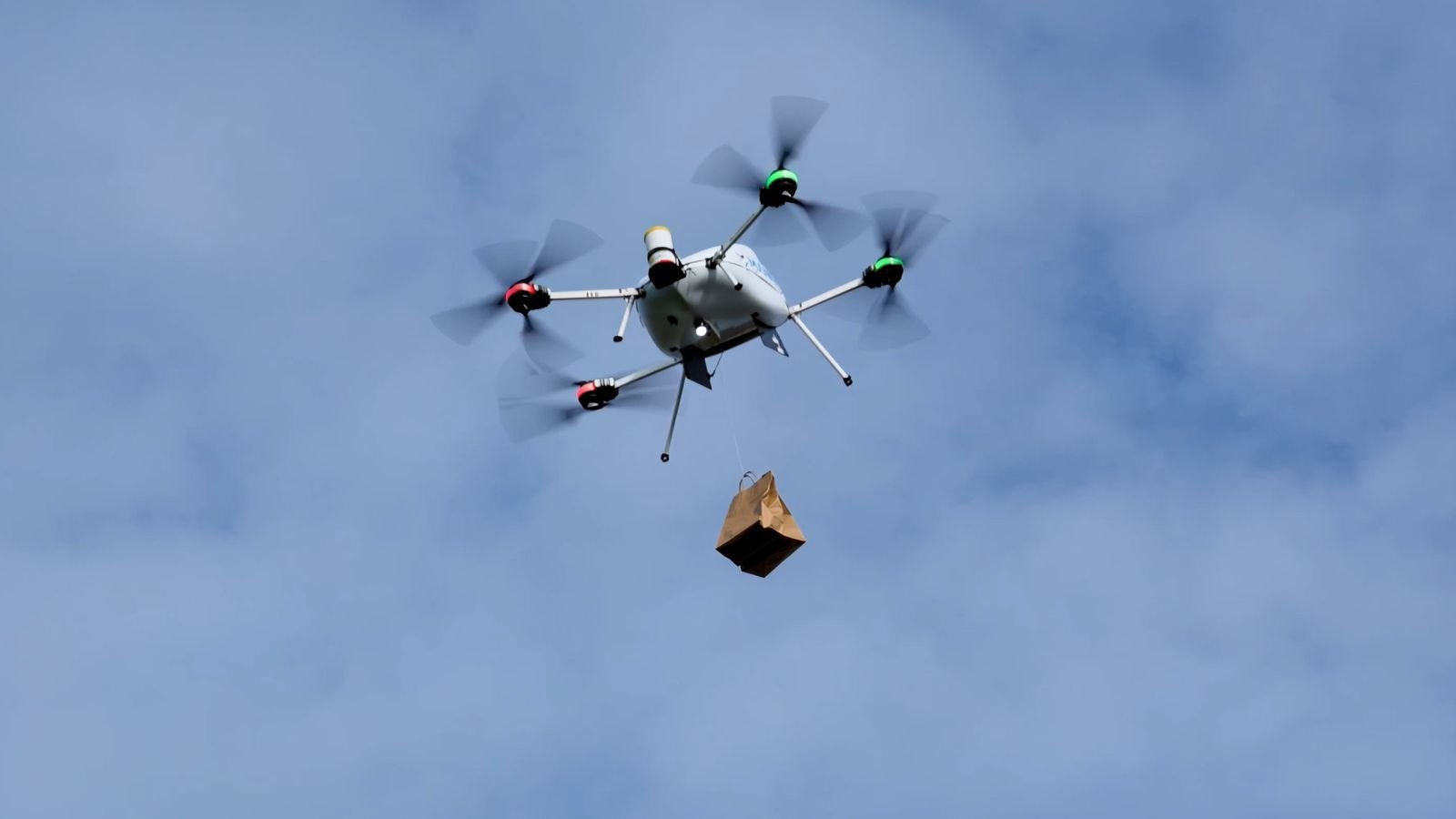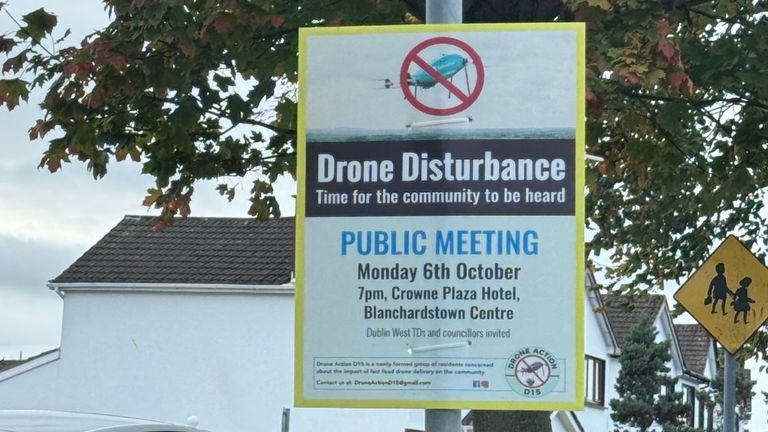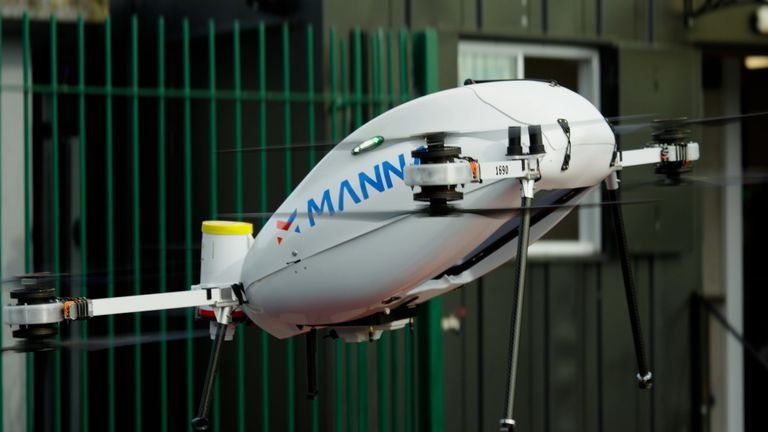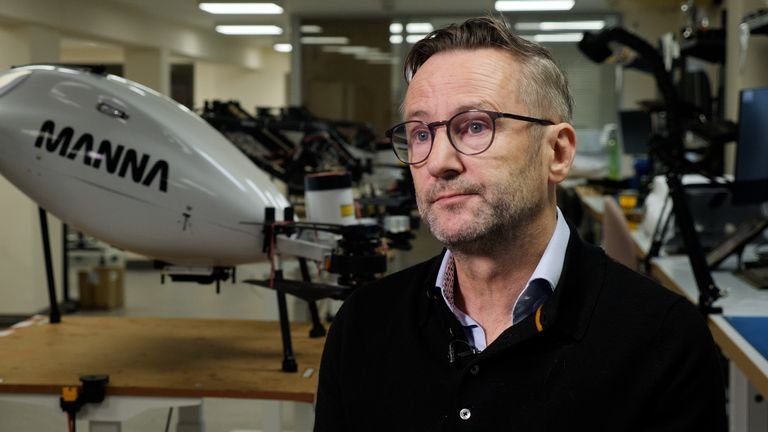An Irish start-up is hoping to have the UK’s first food drone delivery pilot scheme operating in 2026, subject to regulatory approval.
With a fleet of specially designed 23kg quadcopters, Manna Aero has carried out more than 200,000 food delivery flights in west Dublin, Espoo in Finland and Texas.
As the company aims to expand, its CEO Bobby Healy said the UK «would be our most important market in Europe. It’s by far the biggest delivery market today. We think our product maps really well onto the UK high street, particularly».
«We’re actively in dialogue with both the Civil Aviation Authority (CAA) and with NATS (National Air Traffic Services), the airspace manager for the country. And we expect to be there next year,» Mr Healy added.
Manna has completed up to 50,000 deliveries in the D15 postcode of west Dublin since its trial started a year and a half ago.
The drones, which are almost fully autonomous, dart overhead at a cruising altitude of 262ft (80m), carrying everything from burgers and chips to fresh meat from a local butcher’s shop.
Coffee is the most popular order, Mr Healy said, but «we were really surprised that we deliver a lot of fresh eggs. I think people are trying to deliberately test us to see if we can deliver something as delicate as eggs, but it’s not a problem».
Customers must ensure a landing zone – usually a back garden – is clear of obstacles.
This is checked by a human drone operator using a downward-facing camera, before the food is released. The packages descend on a biodegradable string, which is then severed.
«The average flight time is about three minutes. The advantage is that it’s quieter, it’s safer, it’s greener, and it’s better for business generally than the road-based alternative.»
But not everyone in the suburbs of west Dublin is so enthused about their new service.
Mark Hammond, from Blanchardstown, said the noise the drones make «is very stressful, absolutely it is. When it’s constant, you can’t relax. This is across the estate, it’s not just me and [wife] Florence, there’s a lot of concern about it».
As the fourth quadcopter in an hour flew over their back garden, Florence said they «sound like helicopters».
Another resident, Michael Dooley, is part of Drone Action Dublin 15.
He described the noise of the drone flights as «very, very bothersome. The drone, when it flies, has a very tonal, sharp, pulsing, intrusive noise. You’ll hear it coming from afar».
When hovering at their lowest height, to release their cargo, Michael said the sound «is intolerable».
Pointing to a study from Trinity College that found relatively low decibel levels, Mr Healy said: «We know from the science that we’re far less noisy than just general background urban noise. And we’re continually investing. We have new technology coming in, and propulsion and propellers.
«So I don’t think noise is the issue; I think perception is, like any new technology. We had this problem with cars, with steam engines, we had it with every disruptive technology – AI, 5G, you name it. There’s a natural concern to be understood. An Irish start-up is looking to introduce the UK’s first food drone delivery pilot scheme by 2026, pending regulatory approval. Utilizing a fleet of specially designed 23kg quadcopters, Manna Aero has conducted over 200,000 food delivery flights in various locations. The company’s CEO, Bobby Healy, sees the UK as a key market due to its size and potential for growth. Manna has engaged in discussions with the Civil Aviation Authority and NATS to ensure compliance with regulations. The drones operate at a height of 262ft and deliver a range of items, with coffee being the most popular order. Despite some concerns from residents in west Dublin about noise pollution, Manna remains committed to expanding its innovative service.
Healy believes that the UK market is ideal for Manna Aero’s drone delivery service due to its size and potential for growth. With successful operations in Dublin, Finland, and Texas, the company is eager to expand its services and bring innovative food delivery options to UK consumers.
Residents in Dublin have expressed concerns about the noise and disturbance caused by the drone flights in their neighborhood. Florence, a local resident, described the sound of the drones as resembling helicopters, indicating the intrusive nature of the noise.
Michael Dooley, a member of Drone Action Dublin 15, also voiced his concerns about the disruptive noise of the drones. He emphasized that the noise from the drones is not only bothersome but also intolerable at times, especially when they hover at low heights to release their cargo.
Despite a study from Trinity College suggesting relatively low decibel levels from the drones, Mr. Healy from Manna Aero argues that noise perception, rather than actual noise levels, is the primary issue. He believes that as with any new technology, there will be initial concerns that will eventually be accepted over time.
Local TD Emer Currie emphasized the importance of balancing innovation with the impact on residential communities. While innovation is crucial, she stressed the need for regulations to address the concerns of residents affected by drone operations.
The Irish government recently introduced a drone policy framework, but critics argue that actual regulations and legislation are still lacking. In contrast, Manna Aero acknowledges the EU’s drone-friendly regulatory environment and hopes to expand its services to the UK in 2026 pending negotiations with British regulators.
Companies like Amazon are also planning drone deliveries in the UK, with trials being conducted to explore the possibilities of drone usage. However, Ireland’s regulatory framework is considered more favorable to drone companies compared to other regions.
As Manna Aero looks to establish the UK’s first food drone delivery pilot scheme, the company remains optimistic about the potential for growth and innovation in the drone delivery market. With a focus on efficiency and customer satisfaction, Manna Aero aims to revolutionize the way food deliveries are made in urban areas.
Image: Manna Aero
«We’re actively in dialogue with both the Civil Aviation Authority (CAA) and with NATS (National Air Traffic Services), the airspace manager for the country. And we expect to be there next year,» Mr Healy added. Manna has completed up to 50,000 deliveries in the D15 postcode of west Dublin since its trial started a year and a half ago. The drones, which are almost fully autonomous, dart overhead at a cruising altitude of 262ft (80m), carrying everything from burgers and chips to fresh meat from a local butcher’s shop. Coffee is the most popular order, Mr Healy said, but «we were really surprised that we deliver a lot of fresh eggs. I think people are trying to deliberately test us to see if we can deliver something as delicate as eggs, but it’s not a problem». Customers must ensure a landing zone – usually a back garden – is clear of obstacles. This is checked by a human drone operator using a downward-facing camera, before the food is released. The packages descend on a biodegradable string, which is then severed. «The average flight time is about three minutes. The advantage is that it’s quieter, it’s safer, it’s greener, and it’s better for business generally than the road-based alternative.» But not everyone in the suburbs of west Dublin is so enthused about their new service. Mark Hammond, from Blanchardstown, said the noise the drones make «is very stressful, absolutely it is. When it’s constant, you can’t relax. This is across the estate, it’s not just me and [wife] Florence, there’s a lot of concern about it». As the fourth quadcopter in an hour flew over their back garden, Florence said they «sound like helicopters». Another resident, Michael Dooley, is part of Drone Action Dublin 15. He described the noise of the drone flights as «very, very bothersome. The drone, when it flies, has a very tonal, sharp, pulsing, intrusive noise. You’ll hear it coming from afar». When hovering at their lowest height, to release their cargo, Michael said the sound «is intolerable». Pointing to a study from Trinity College that found relatively low decibel levels, Mr Healy said: «We know from the science that we’re far less noisy than just general background urban noise. And we’re continually investing. We have new technology coming in, and propulsion and propellers. «So I don’t think noise is the issue; I think perception is, like any new technology. We had this problem with cars, with steam engines, we had it with every disruptive technology – AI, 5G, you name it. There’s a natural concern to be understood. And I think over time it will be generally accepted.» Read more from Sky News: Nova festival survivor dies two years after girlfriend killed Paedophile Lostprophets singer dies after prison attack Police try to keep protesters apart at Gaza war demo The Drone Action Dublin 15 group disputes the methodology of the Trinity College study. Local TD [member of parliament] Emer Currie said that with worries about «a new M50 [motorway] in the sky», it’s a balancing act in the area. «We do have to be realistic about this. Yes, this is innovation and things are moving forward. But there are realities of the impact on a residential community that have to be taken into consideration. Innovation is crucial, but regulation is equally important. The Irish government has recently introduced a drone policy framework, however, critics argue that there is still a lack of actual regulations and legislation in place.
Manna recognizes that the EU has a more drone-friendly regulatory environment compared to other regions such as the UK and the US. Despite this, the company is determined to bring its services to UK consumers by 2026 if negotiations with British regulators are successful.
Companies like Amazon are already making plans for drone deliveries in the UK, with the Civil Aviation Authority selecting them as one of six companies to participate in trials to expand drone usage. However, Ireland’s regulatory framework is more favorable towards drone companies.
SOURCE




